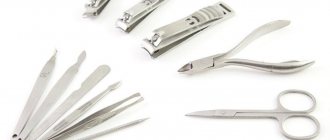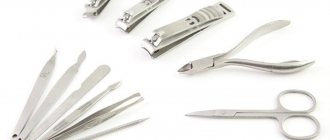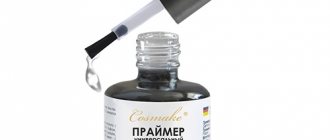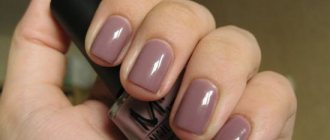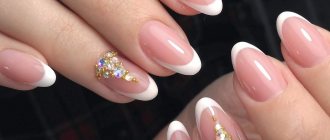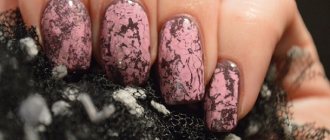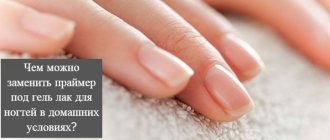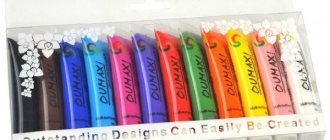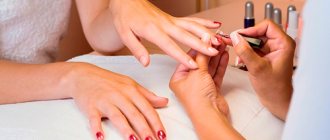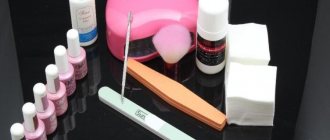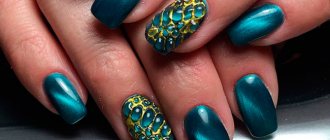All girls want to stand out and attract the attention of others, which is why they pay such close attention to beauty issues. This includes facial, body, hair care and, of course, a flawless manicure, which is not complete without a color coating!
From the article “What is gel polish?” We have already learned how many advantages this material has! No wonder he was loved by millions of girls all over the world. But what if a girl doesn’t want to spend money and go to a beauty salon or a manicurist? How to apply color coating at home? What will you need for this?
Before applying gel polish, it is necessary to carry out preparatory procedures: do a manicure and properly prepare the nail plate for coating. And after applying a colored coating, you can complement it with a simple design and carry out care procedures that will help preserve the beauty and youth of your hand skin.
Conventionally, the entire procedure can be divided into the following stages:
- manicure;
- preparing the nail plate for coating;
- coating of the nail plate;
- design;
- hand skin care.
We will analyze the materials and tools needed for each stage, and the technology for applying gel polish at home.
Stage 1. Manicure before gel polish
Before applying gel polish, you need to get your nails in order. Treat the cuticles and give your nails a beautiful shape. At this stage we will need:
- orange stick;
- pusher;
- cuticle remover;
- scissors, tweezers or nippers for removing cuticles;
- file for natural nails.
Orange sticks medium 17.8 cm IRISK 90-100 pcs
Manicure pusher P-06 small spatula/hatchet length 132 mm Nippon Nippers
Cuticle Eliminator Be Natural 59 ml
Cuticle scissors matte S-03 length 90 mm Nippon Nippers
Disposable files 220/280 11.5 cm (03 Lemon) IRISK 10pcs/pack
Today there are 3 main types of manicure:
- hardware;
- combined;
- classical.
Hardware and combined manicures are done using a special device. Before using it, it is better to undergo training, since if used incorrectly, you can damage the nail plate.
It is better to do a classic manicure at home.
What do we do at this stage?
- Using a file, give the free edge the desired shape.
- Apply cuticle remover to the cuticle and side ridges.
- Place your hand in a bath of warm water for 3-4 minutes. We wipe our fingers and start manicure.
- Use a pusher to push back the cuticle.
- We remove the cuticle with scissors (tweezers, nippers).
- With an orange stick dipped in water, we go along the contour of the nail and clean the pterygium.
What gel polish kits exist?
Many manufacturers produce ready-made, fully equipped starter kits for working with gel polishes, complete with or without a lamp (in this case, it must be purchased separately).
Our online store also offers the purchase of ready-made shellac kits, collected by us according to all criteria of quality and convenience of goods:
- mini (without a lamp and with a minimum amount of products necessary for manicure);
- maxi (with a lamp included, with the maximum possible amount of all the products necessary for manicure).
- base + top
Stage 2. Preparing the nail plate for coating
Next, you need to prepare your nails for a manicure with gel polish. This stage is very important, since it determines how well the adhesion of the natural nail and the artificial coating will occur. To carry out proper preparation, we will need the following materials:
- buff;
- brush or brush for removing dust;
- lint-free wipes;
- 2 in 1 liquid: degreaser and sticky layer remover - this product removes natural deposits (grease and dust) from the surface of the nail plate, thereby preparing the plate for better adhesion to the artificial material;
- dehydrator (nail-prep) - deeply dries the nail plate and removes excess moisture from it. A dehydrator is a must for people with oily skin and prone to excessive sweating, since usually the structure of their nails is damp and oily, which impairs adhesion to artificial turf;
- primer - translated as “primer”. There are acid-free and acidic primers.
The acid-free primer acts as double-sided tape and ensures strong adhesion of the natural nail to the artificial nail.
The acid primer lifts the keratin scales of the nail plate for better adhesion to the artificial material. Since the acid primer contains aggressive components, you must be careful not to get it on the skin and cause a burn. It is recommended to use it before extensions for girls with wet or oily nail texture.
What do we do at this stage?
- We treat the surface of the nail plate with a buff to lift the scales of the nail plate and improve adhesion.
- Remove dust with a special brush.
- Apply degreaser to a lint-free cloth and wipe your nails. If you want to make the process as comfortable as possible, we recommend using liquids without chemical fragrances, such as ParisNail liquids. They have pleasant aromas and 100% rid the nail plates of germs, grease and dirt, thus guaranteeing long-lasting wear of the coating.
- If you have oily skin, then to improve adhesion, apply a dehydrator to the entire surface of the nail and air dry for a minute.
- Then you need to apply primer to the free edge of the nail. The free edge is one of the most vulnerable places, and thanks to the primer, the adhesion between the nail plate and the artificial material improves, which contributes to longer wear of the coating. We also air dry the primer for one minute.
Modern nail design and materials for it
Design has several directions that are very different from each other:
French manicure or French manicure, lunar design
Materials: varnish of two colors. The simplest and most common. The nail is covered with pastel-colored varnish, and the regrown part of the nail is covered with a different color or shade. Recently, it has become more complicated - the grown part of the nail can be covered with a print or painted artistically. Or the nail hole or nail bed is painted with light varnish, and the rest is colored.
Artistic painting
Materials: base varnish; water- or varnish-based artistic paints are applied on top. Water-based paints are easy to paint, mix well, and are easy to wash off with water if something doesn’t work out. The design is applied with brushes, wooden sticks, pipettes, and pins. The top is coated with a transparent fixing varnish.
Aquarium
Materials - colored acrylic, rhinestones, sparkles, foil, even dried flowers. You can show your imagination and come up with anything else. It is done with nail extensions or on artificial nails. The design or decoration appears to be inside the nail and is covered with transparent acrylic.
Volume
Materials – base varnish, gel, acrylic paints, acrylic powder, decorative elements – patterns, appliqués, symbols, rhinestones, figured sparkles. This is a bold and unique design. Lasts about 3 days. It is done both on the nails themselves and on artificial ones. The composition is coated and secured on top with transparent varnish. This decoration is only for going out and celebrating.
Photo print, stickers with various images
Materials – base varnish, special stickers, top varnish. This is the latest trend in nail art. Special printers print nail stickers, they are glued and coated with a protective colorless varnish. This is probably the simplest long-lasting manicure. Done correctly, it can last up to 3 weeks.
Gel polish (shellac)
Materials – colorless gel for adhesion to the nail, shellac. Ultraviolet light is used for polymerization. Very durable coating, lasts up to 20 days. Allows you to make a lunar manicure, gradient, French, decorate with sparkles and rhinestones. In general, almost everything from the previous techniques. The only downside is to check how your nails react to shellac. After one application of shellac, you need to take a break. This is quite a heavy nail decoration. And it’s better to do it in a manicure salon.
Stage 3. Covering the nail plate
Next we move on to the most anticipated stage - coating.
We will need:
- base coat;
- color coating;
- top coat (with or without a sticky layer);
- lamp for polymerization. For more information on how to choose a lamp, read the article “How to choose a lamp for drying gel polish?”.
Rubber base for gel polish Rubber Diva 15 ml
Gel polish NR-100 Nail Republic 10 ml
Sticky Top by Mystique 15 ml
Top without sticky layer Haruyama 8 ml
Lamp UV/LED Perfect Lamp 2+ 48 W with three pads black ParisNail
If you don't want to make designs and use a top with a sticky layer, then we will also need:
- lint-free wipes;
- 2 in 1 liquid: degreaser and sticky layer remover.
What do we do at this stage?
- Apply a base coat to the surface of the nail. Dry it in a lamp. We do not remove the sticky layer.
- Apply gel polish, if necessary in 2 layers. We dry each layer in a lamp. We do not remove the sticky layer.
- Apply top coat. Dry it in a lamp.
- If you are using a top coat with a sticky layer, then moisten a lint-free napkin with a sticky layer remover and wipe your nails with it.
Design materials
Lucky
- Degreaser (primer) – to prepare the surface before applying shellac (can be replaced with simple medical alcohol)
- Base or base-top varnish – acrylic or acetate, for leveling and preparing the nail surface for design, with additives for healthy nails, or special for shellac
- Colored varnish – polymer acetate or acrylic
- Python varnish – to depict antique cracks
- Shellac is the most durable decorative layer, lasts for 2 weeks. A special shellac base is applied underneath it. It is polymerized with a special lamp, and after that the decorative layer itself is applied. It is better to apply in salons; it is not suitable for home design.
Stage 4. Nail design
Now you can move on to the designs. Since we make the coating at home and are not professionals, it would be logical to use the simplest designs. But don't be discouraged, they are very stylish and impressive!
For example:
- slider designs;
- stickers;
- foil.
Slider design Ibdi_Nails AIR FOIL 13
Stickers F660 Leaves gold
Foil for casting gold 4 cm*1 m RocheNail
In addition to the designs themselves, we may need a top coat to secure the sliders or glue for the foil.
Top for designs Factor Lianail 10 ml
Glue for foil ARTEX 15 ml
Now let's look at how to make each of the proposed design options.
Slider designs:
- Those nails on which we will attach slider designs do not need to be covered with topcoat;
- Soak the pre-cut slider design in water, dry it on a napkin, then separate the film from the backing;
- Apply the base coat. We do not dry it;
- We plant the design on an undried base coat. In order not to damage the slider design when smoothing it over the nail, you can use a brush or silicone hoof;
- Dry the base coat together with the slider design in a lamp;
- Apply a topcoat to secure the sliders. Dry it in a lamp.
Stickers:
- If they are used, it is necessary to remove the sticky layer from the coating;
- Remove the sticker from the backing, cut it if necessary, and apply it to the nail plate;
- Cover with topcoat and dry in a lamp.
Foil:
- If you decide to use foil as a design, then after applying gel polish you do not need to use a top coat;
- We firmly press the matte side of the foil to the sticky layer of dried gel polish and sharply tear it off. Dry in a lamp;
- We apply the top coat and dry it again in the lamp.
TIP: if the stickiness of the gel polish is not enough and the foil does not print, then you should use a special glue for foil.
It's very easy to use. Remove the sticky layer from the colored coating, apply glue to the surface of the nail and wait until it becomes transparent. This means the glue has dried. Then we print the foil as described above, secure it with topcoat and dry it.
Lucky
Nail art uses many different varnishes, bases, fixatives and other related liquids.
Base varnishes (base varnish), or primer varnishes, are colorless and increase adhesion to the nail, protect against the action of coloring pigments and aggressive components of the varnish:
They are applied to the natural nail before applying colored varnish.
Colored varnish (liquid enamel) is used to add color and shine to nails. It is usually applied in two layers:
The color varnish contains a solution of nitrocellulose in a bulk solvent such as ethyl acetate, which evaporates easily.
Manufacturers add castor oil to the varnish to prevent it from drying out too quickly.
Thanks to the acetone-free base, the varnishes are perfect for both natural and artificial nails.
Each bottle of varnish is equipped with a brush, the length and thickness of which meets professional standards.
The brush is fixed in a lid, the shape of which is designed taking into account all the rules of ergonomics, and is therefore convenient to use.
Varnishes differ not only in price and volume, but also in properties.
The first and most common varnish is simple, usually applied in two layers; for dark shades, one is enough.
There are also single-layer varnishes, where application is carried out in one layer.
Pearlescent varnish has a golden or silver tint:
There are also express varnishes that dry in 2-3 minutes.
Chameleon varnishes change color under ultraviolet light or depending on the angle of the nail, thermal varnishes - depending on the temperature in the room or outside:
Hypoallergenic varnishes are sold in pharmacies and do not cause allergies due to the absence of toluene, formaldehyde, and dibutyl phthalate.
Matte varnishes do not shine, even if the nails are even and smooth, and they also dry out faster:
Watercolor varnishes create a visual impression as if they have not dried completely and are actively used in nail art and French manicure.
Cracked varnishes (“the effect of old porcelain”) create on the surface of the nail the effect of cracks spreading in different directions:
Film varnishes are water-based and are removed by pulling off the entire coating with film.
Bitter varnishes were invented specifically for those who cannot wean themselves from the habit of biting their nails.
Varnishes for nail art are dense in texture and pure in shades. They are usually sold in a set of 6-10 bottles with brushes for nail design.
At the same time, drawings made with varnishes can be corrected using a manicure corrector:
Only in this case you need to act carefully: the corrector can erase not only the drawing, but also the varnish applied for the background.
Therefore, you do not need to rub or drag the corrector along the incorrectly applied line; you need to lightly touch the place that needs to be removed, it will dissolve and absorb the varnish.
Hand skin care
In order for the skin of your hands to maintain beauty and youth for many years, it is necessary to do skincare procedures. We will need:
- cuticle oil;
- hand cream.
At the end of the manicure, you need to apply cuticle oil. Place a drop of oil on the cuticle of each nail and rub well. Please note that there are mineral and natural oils. Mineral oil forms an invisible film on the surface of the cuticle. If you use this oil every day, you will get the opposite effect: the cuticle will begin to dry out. This oil is more suitable for masters: the client comes for a manicure once every 3-4 weeks, and mineral oil is ideal for single use. At home, on a daily basis, it is better to use natural oil, for example “Dadi Oil”, “ruNail”.
Organic oil for nails and cuticles Dadi Oil Famous Names 3.75 ml
After the oil, you need to apply a moisturizing or nourishing cream to the skin of your hands and cuticles.
NOTE! It is necessary to take care of your hand skin not only after a manicure! Before going to bed, smear your hands with a moisturizing or nourishing cream, and in the cold season, before going outside, with a protective cream. Once every 1-2 weeks you can scrub and perform paraffin therapy. To save time and money, you can purchase cream paraffin from “Aravia”.
Cream paraffin Flower nectar with flower and beeswax ARAVIA 300 ml
Let's look at the technology for using such a cream.
- Thoroughly scrub your hands to remove dead skin cells.
- Apply a moisturizing or nourishing cream and rub it in well.
- Apply a thick layer of paraffin cream.
- We put on plastic gloves and do not take them off for 15-20 minutes.
- After the specified time has passed, remove the gloves and wipe off the remaining paraffin cream with a paper towel.
After the procedure, it is advisable not to wet your hands for two hours.
Be sure that after such care your hands will tell you: “Thank you!”
What difficulties may arise when applying gel polish at home?
- Unable to apply coating accurately
- Gel polish shrunk during polymerization in a lamp
- There are bubbles in the gel polish
- The coating peels off after a few days
The main advice: don’t get upset, be patient and practice this skill. It’s better to get trained at our licensed school “ParisNail”!
One of the reasons may be insufficient lamp power. Perhaps your gel polish is well pigmented and the lamp power is simply not enough to dry it. It is advisable to use a lamp with a power of at least 48 W. Also, the gel polish could shrink due to the fact that you applied it in too thick a layer.
This may happen due to the fact that the bottle of gel polish has been shaken. To get rid of bubbles, you need to open the bottle, but do not remove the brush. Let the material stand in this state in a dark place so that it is not exposed to daylight for a couple of hours. After this, you need to mix the composition with a brush, close the bottle and twirl between your hands.
Perhaps you made mistakes when preparing the nail plate for coating or in the technology of applying gel polish. Also, the reasons may be an incorrectly selected base or top. For information on how to choose them, read the articles “Base for gel polish. What is it and what is it for?”, “Top for gel polish. What is it and what is it for?
How to save money on manicure?
Do you want to perfectly master the art of manicure from A to Z and never spend 2,000-3,000 rubles in a salon again? Then learn how to do a manicure yourself and save money, time and nerves!
Come to our School for an online course from top teacher Tatyana Svoboda “Manicure for yourself,” which can now be completed for only 499 rubles !
The teacher will tell you all about the technique of applying the coating, removing it, modern designs, how to strengthen your nails, and much more. You will become a real pro and will be able to create your dream nail designs, and, if you wish, monetize your hobby in the future!
Course bonuses:
We give all students a 15% discount on ready-made manicure starter kits, as well as a 5% discount on purchases at ParisNail and 15% on any other online course. Upon completion of the training, you will be issued an electronic certificate of completion of the course.
